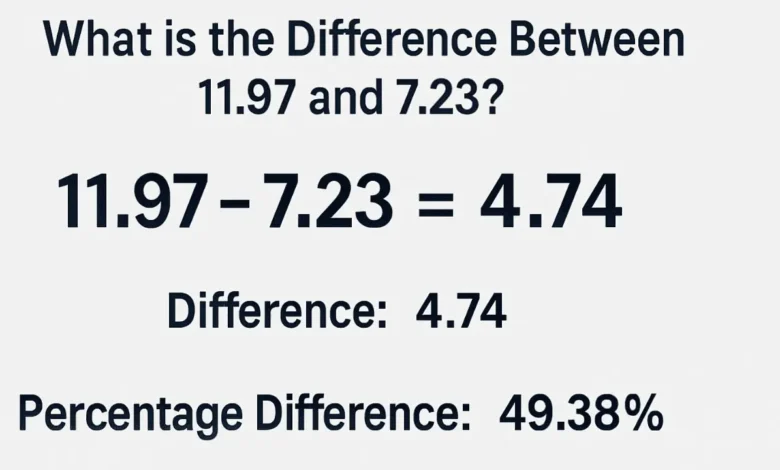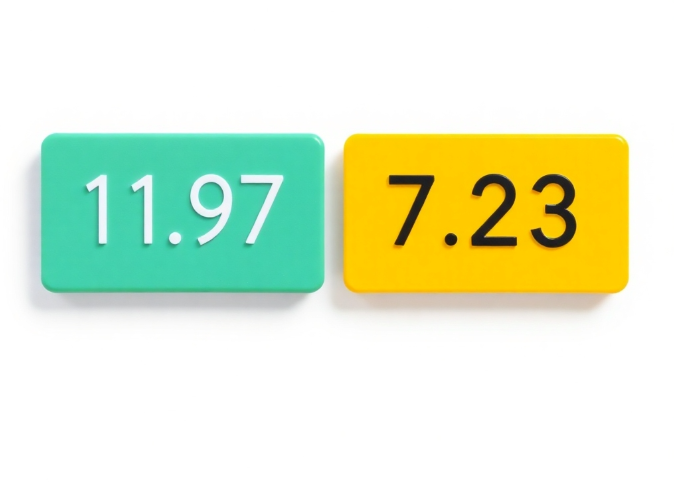Table of Contents
Introduction to the two numbers
Often, seemingly minor differences do not mean much to us, for example, 11.97 and 7.23. These numbers are not more than one- and two-digit decimals on a page or spreadsheet. However, they are much more than that. Their true meaning reveals a fascinating tale.
These figures are more than symbols; they are values that can impact our daily activities without us realizing it. Knowing the what is the difference between 11.97 and 7.23, for example, when online shopping or allocating funds to supermarket groceries, can assist one in making better decisions.
Come with us as we examine this precise twosome to figure out how spotting such distinctions is more critical than you ever considered!
Explanation of decimal numbers and their significance
We encounter decimal numbers daily. They allow a more accurate estimation of value ranges that fall beneath rounding thresholds.
Grasping the concept of decimals is fundamental when performing various activities, from grocery shopping to financial planning. This can be illustrated by the case when prices are displayed as $11.97 and $7.23; those exact numbers are significant.
Decimals are equally crucial in scientific fields requiring precision. Consider areas like engineering and finance – the tiniest decimal can drastically alter the results.
Decimals also have a purpose outside of mathematics. They facilitate communication within many professions, whether interpreting data trends or calculating grades. Comfort with decimal notation improves decision-making and communication skills.
Understanding 11.97 and 7.23

While numbers such as 11.97 and 7.23 might initially appear unremarkable, they take on significance that varies with the context in which they are applied.
For example, 11.97 is almost, but not quite, twelve. It often represents something nearly complete or close to a milestone. Similarly, 7.23 is less than eight but more than seven, a gentle nudge of advancement and opportunity.
As we can see, the decimal portion of the number adds essential information, further verifying its importance. Similarity matters a lot in decimal digits.
In our day-to-day activities like shopping or even scoring in an exam, these figures could reflect prices, scores, or even measurements, revealing more in-depth information about how we prioritize our decision-making and processes.
Real-life examples of when these numbers are relevant
Considering the what is the difference between 11.97 and 7.23 brings to mind several real-world cases. Picture yourself going shopping for groceries. You might come across one that costs $11.97 and another that costs $7.23. This decision can affect your weekly expenditure.
Tracking calories can also significantly improve fitness. Would your meal planning change if one of your snacks had 11.97 grams of protein instead of 7.23 grams?
Travelling is another example of how these numbers greatly matter—every cent is significant when budgeting a trip, such as when calculating fuel costs, hotel prices per night, and more.
As noted earlier, minute details can make a difference even with investments. As such, if an interest rate is 11.97% compared to 7.23%, the return by the end of the investment period could be thousands more.
These digits are more than mere numbers; they showcase the decisions we make every day and the ways we choose to live.
The impact of the difference between 11.97 and 7.23
The gap between 11.97 and 7.23 goes beyond mere numbers; it indicates probable alterations in various settings.
This small margin can influence spending decisions. For example, a person may pass on an item costing 11.97 after noticing an alternative priced at only 7.23.
In retail, these figures refer to items of different worth or quality.
Customers often evaluate what they gain from each price point.
Investors also feel the impact of such differences when assessing investment returns or transaction costs. Every cent counts when building wealth over time.
This gap can affect seemingly mundane activities like eating out or spending time at the mall, motivating smarter spending habits. It can also help people evaluate what is essential in life and prioritize their expenses.
How this difference affects personal finances and decision making
When considered in the bigger picture of personal finance, even the tiniest details can have a ripple effect. For example, whether someone will surpass their financial budget depends greatly on numbers like what is the difference between 11.97 and 7.23, regardless of how minuscule the variance appears.
In this case, the additional grocery value could impact your monthly fuel and grocery expenses. Tracking where your money goes is very important if you are trying to save money.
In addition, knowing these figures helps you compare prices while shopping online or making other purchases. These discrepancies, however minor they appear, can accumulate over time and contribute to savings or overspending.
Understanding the implications is just as crucial in January’s annual percentage rate (APR) thought processes as understanding credit cards and loans. A slight change in percentage points might alter repayment amounts significantly over the long term.
Paying attention to these decimal distinctions fosters smarter financial choices and encourages better management of resources in everyday life.
Conclusion: The importance of paying attention to seemingly small differences in numbers
Even the most minor differences in numbers can have significance in real life. For instance, while what is the difference between 11.97 and 7.23 may seem close when first looked at, the 4.74 difference means so much regarding budgeting or decision-making.
It is essential to grasp how these numbers play out in real-life situations. Whether estimating costs, measuring spending, or determining returns on investment, understanding the logic behind them enables smarter choices when dealing with finances.
Every dollar is crucial when managing personal expenses. An oversight can cost a family money that could have been saved or invested for much better future returns. Therefore, being detail-oriented is extremely important, even if it looks negligible at face value.
This insight extends beyond finance into everyday situations—whether tracking progress on fitness goals or determining quantities while cooking recipes. Practising mindfulness of paying attention to more minor number differences improves decision-making and awareness.
Mathematics is far more than an abstract discipline. Every number tells a story relating to one’s life and their decisions. Even the most trivial-looking gaps have information hiding beneath their surface. For that reason, such gaps should be looked into closely.
FAQS
1. What is the result of calculating 11.97 – 7.23?
This corresponds with my first answer of 4.74.
2. Revealing the importance of knowing the difference between 11.97 and 7.23 is equally vital today.
The 4.74 difference is highly relevant when distinguishing what is the difference between 11.97 and 7.23 in financiers or budgeting responsibilities where small numbers matter and buildup is essential.
3. How does the financial gap impact spending decisions of 11.97, 7.23, and 4.74?
In this case, we are dealing with a difference of 4.74, which influences spending, saving, and financial strategy formulation.
4. Can a difference of 11.97 and 7.23 impact cooking measurements?
A deviation of 4.74 units from 11.97 or 7.23 grams can change the recipe’s result.
5. Would a .74 point difference in grading systems like school GPA carry weight?
Using letter grades or GPAS, the results would show the gap differing by 4.74 points, and changing from 11.97 to 7.23 would dramatically impact letter grades and GPA results.
6. How does the subtraction of what is the difference between 11.97 and 7.23 affect fuel consumption?
The differences between the dual values 11.97 and 7.23 yield 4.74 litres of fuel, which is considered significant in consumption or efficiency terms.
7. What is the method to determine the percentage change from 11.97 to 7.23?
From that, when computing the numbers what is the difference between 11.97 and 7.23, the value of the percentage difference that I obtained is nearly 50.9%. The process I utilized can be expressed with this formula: (4.74/ ((11.97 + 7.23)/(100/2))) * 100.
8. What is the consequence of 11.97 and 7.23 in correlation with pricing strategies in the retail sector?
Such a slight $4.74 difference between 11.97 and 7.23 can significantly affect how people view consumer competition concerning pricing.
9. Does the difference between 11.97 and 7.23 hold relevance in weight measures?
The distinction between 11.97 and 7.23 kilograms or pounds is considerable regarding shipping or health. 4.74 units differ in this context.
10. How does knowing the gap of 11.97 and 7.23 improve data analysis?
The difference between 11.97 and 7.23, 4.74, helps better manage and calculate the data.
